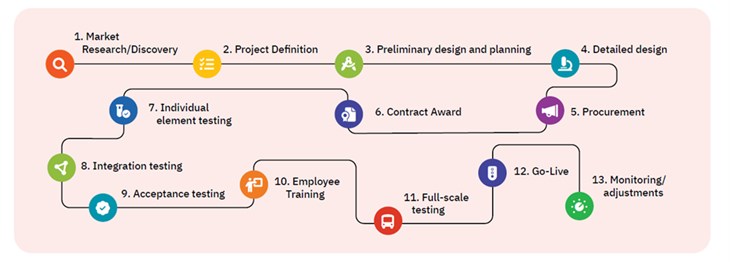Starting Your On-Demand Transit Service: Things to Consider

The Canadian Urban Transit Association (CUTA) has an excellent On-Demand Transit Toolkit to guide agencies considering implementing paratransit or microtransit services. Taking into account that every agency’s needs are unique and dependent on varying factors, CUTA’s aim is to help agencies ask themselves the right questions before implementing on-demand transit services.
What are On-Demand Transit services?
On-demand transit services enable riders to request a ride on a specific date and time. They book and pay for rides via website, mobile app, or a phone call, while drivers use an in-vehicle device or driver app to receive pick-up and drop-off instructions.
Where can On-Demand Transit be implemented?
On-demand transit can be implemented in areas with low transit demand, low population density, areas with disconnected road networks which impede fixed-route transit services, or to compliment existing services or expand service coverage.
How does On-Demand Transit work?
Traditionally, booking an on-demand transit service ride involved riders calling a central helpline to book a pick up. Today, the process is facilitated more quickly and efficiently with automated scheduling software and passenger information systems like TripSpark’s Rides on Demand app, making it easier for riders to book a paratransit or microtransit ride to their destination.
How can agencies setup On-Demand Transit services?
An on-demand transit service can be managed efficiently and cost-effectively using a combination of automated scheduling and dispatching software, in-vehicle technology, and passenger information systems. This powerful combination of solutions removes the manual work while giving agencies an overview of fleets and routes in real-time.
In CUTA’s On-Demand Toolkit, setting up on-demand transit is broken down into five key areas. Here are some of the highlights:
Planning
Every agency has unique circumstances depending on its location, region and the applicability of State and Federal regulations. CUTA recommends asking yourself the following questions when planning to implement on-demand transit services.
1. What are the objectives and goals of the service?
2. What is the size of the service area?
3. Who is the customer base (e.g., students, seniors)?
4. What is the service delivery model?
5. What type of vehicles will be used and how many?
6. When will the service operate?
7. What are the benefits of implementing on-demand transit into the current system?
A key feature of planning your on-demand transit project is to create a roadmap of the service. To make this easier, here are the steps to move from an implementation stage to a test run, before rolling it out to the general public.

Figure 1 – Illustration of the on-demand transit service implementation process. Source: CUTA On-Demand Transit Toolkit, May 2022
Operations
Once you have moved past the high-level planning stage, its time to get into the details of the plan by asking:
1. How will your operations to work?
2. Do you want to run your on-demand transit service yourself or partially/fully outsource the operations to a third-party?
3. What is the most cost-efficient yet reliable option?
4. What would the fare structure be? Would it be fixed-rate fare, distance-based, or a free service? What would be the implications on your finances?

Figure 2 – Flowchart to decide the right operating business model for on-demand transit service implementation. Source: CUTA On-Demand Transit Toolkit, May 2022
Accessibility
On-demand services can increase transit access for low-income populations and riders with disabilities. Compared to fixed-route services, on-demand transit is more flexible with requested pick ups and drop offs, and can accommodate riders with limited mobility. If an area has no existing transit service, on-demand transit can provide critical access to individuals who have no other means of transportation.
Here are some of the considerations for creating an accessibility-friendly on-demand transit service:
1. Providing options to call or text to book rides.
2. Providing a passenger portal or mobility app designed for accessibility.
3. Providing options to book in different languages.
4. Providing accessible vehicles that can accommodate wheelchairs, strollers, and other mobility devices.
5. Permitting both cash and electronic forms of payment.
6. Ensuring stops are accessible (e.g., ramp-friendly sidewalk near the bus stop).
Customer Experience
Providing real-time information about your vehicles and schedules with a user-friendly passenger information system helps riders navigate your on-demand services. When riders can easily plan and book a trip, get directions to the stop, and monitor the arrival of vehicles on a map, it takes the stress out of taking transit and increases trust with your agency. Reliable, seamless journeys are what turns satisfied riders into loyal customers.
Data Monitoring & Performance Evaluation
Transit systems are under increasing pressure to improve performance and demand for service while simultaneously juggling financial constraints. By continuously measuring key performance indicators (KPIs) like vehicle utilization, cancelled or no-show trips, and rider numbers, your agency can ensure that resources are being efficiently utilized.
An important observation that CUTA determined from American transit systems that implemented on-demand transit was that its success or failure should be determined based on performance metrics that look at not just ridership and farebox recovery, but also several other parameters like customer experience across various population demographics, improved mobility and increased safety.

Figure 5 – Measuring performance of on-demand transit service systems. Source: CUTA On-Demand Transit Toolkit, May 2022
Additionally, reporting it in the expected format to State and Federal regulatory bodies is another challenge for agencies. On-demand software with built-in reporting capabilities helps agencies generate reports in a the acceptable NTD format without spending hours manually putting it together yourself.
For a deeper dive into what is involved with planning an on-demand transit service, check out the full CUTA on-demand transit toolkit.
